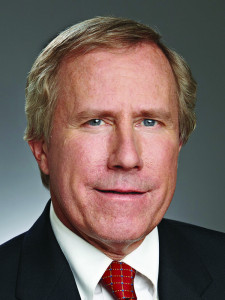Regional banks play an important role in serving the small to middle-market businesses, which help fuel the country’s economic engine. The banks offer an expanding selection of financing products while staying engaged with their clients, talking to them daily, recognizing specific challenges and thoroughly understanding their business goals. Many of the regionals have acquired or developed ABL shops to fulfill their clients’ lending needs while staying viable in an active but not necessarily robust economy.
Four ABL executives associated with regional banks stretching from the West Coast to the Mid-Atlantic join us for this roundtable, which begins with a discussion about the growing role of regional banks, the unique value they bring and the competition they feel from the big banks and growing community banks.
Bridge Bank began as a community bank, started an ABL group to differentiate itself in the marketplace and has grown into a $20.8 billion regional bank. “Some of the national banks do a phenomenal job on $100 million loan facilities, but they might not pay as much attention to the companies that need a $1 million facility,” says Christopher Hill, SVP and regional director of Capital Finance at San Jose, CA-based Bridge Bank. “We are willing to start with companies when they are smaller and grow with them as they graduate to different parts of the bank and perhaps no longer need the controls of an ABL facility.”
“Regional banks typically focus on companies with $10 million to $500 million in revenues,” says Ron Vanek, president and CEO of Dallas-based Marquette Business Credit. “We fit into that space very nicely, and ABL is a good addition to the regional bank offerings.”
“Over the past three to five years, we have seen the smaller regional banks start their own ABL groups by hiring experienced ABL lenders from larger banks,” says Mark Foster, EVP of Asset Based Lending at Boston-based Berkshire Bank. Foster joined Berkshire as part of the team in 2010 to start and build the bank’s asset-based lending business. “This is a trend that seems to have peaked. It is a difficult market, and some of the groups are struggling with loan volume.”

“Asset-based lending requires professionals who have a significant amount of experience in the business,” says Andy McGhee, president of Atlanta-based AloStar Capital Finance. “If an institution wants to be in the ABL business but is only willing to focus on a local market, it’s difficult to scale the business and drive an acceptable return. I do think regional banks will play a bigger role, but they need to staff themselves appropriately if they are going to be significant players.”
The value of a regional bank is derived from its local knowledge, broad representation and ability to build true relationships with customers. “When there is a problem, they know exactly who to call,” Hill says. “That beats a faceless 1-800 number where you don’t get personalized service and attention. This is how we win against the national banks’ low pricing and structures.”
“Our advantage is we are more relationship-based than transaction-based and have local decision-making that allows us be quick to the market,” Foster says. “The national banks will sometimes come down to compete with us on these smaller deals, but they are not as attentive as we are to the smaller prospects.”
With shrinking margins, declining loan yields and increased regulatory burden, more and more community banks are merging to stay competitive. With balance sheets consisting mostly of real estate, they look for ways to diversify their revenue stream, risk profile and loan portfolio. “More and more community banks are building C&I platforms and dipping their toes into the ABL market,” McGhee says. “It wouldn’t surprise me to see super-community banks build asset-based platforms as asset generation and diversification of risk become an even more important part of their business models.”
Vanek says Marquette Business Credit typically does not cross paths with the larger community banks. “As the community banks get larger, they get to a point where they are not really a community bank anymore. They become more of a large local or even a regional player. To be a real competitor of ours, banks have to bring in the expertise to do asset-based lending, and we have not seen that to date.”
Berkshire Bank does feel some heat. “Another aspect of the competition is that they usually look toward other established ABL providers to attract an experienced asset-based lender to start up their business,” Foster says. “There is competition for manpower as well as transactions.”
Hill agrees. “They’ve hired many good people from our bank and Silicon Valley Bank to build teams with experienced asset-based lenders. With these teams in place, they are valid competitors. They put pressure on pricing and structures, because there are now more hands out there looking for the same deal.”
Finding New Ways to Compete
Increasingly, regional banks work with alternative lenders to bring a portion of the financing solution which will meet a customer’s needs without defying regulatory guidelines. As Berkshire Bank’s portfolio companies age and mature, Foster finds they become attractive to private equity buyers. “That’s when we play in that space,” Foster says. “It’s usually when we’re involved in some type of M&A or buy-out. We come in to do the traditional asset-based financing, and the alternative lender does the stretch piece or cash-flow strip and gets their premium pricing.”
“We work with mezzanine or venture debt players who ask us to look at some high leverage deals,” Hill says. “We keep within the leverage requirements and let them take on the more senior debt, where there may be cash flow or structural issues we can’t get comfortable with. These players are good partners if we can structure the correct intercreditor and subordination agreement.”
Marquette Business Credit works with business development corporations. “We’ll do the revolving line of credit secured by the receivables and inventory, and the BDC will do the term debt secured by the fixed assets,” Vanek says. “We’ve done multiple deals with a couple of the BDCs, and that makes our association more comfortable. It also makes the documentation easier when we consistently do deals together.”
McGhee observes Alostar’s partnership with non-bank ABL players provides opportunities to find new business, allows the bank to be involved in more complex transactions and lowers the average cost of capital for the end client. “Partnering with non-bank finance companies provides a solution that segments the risk into buckets that are appropriate for each one of the investors involved in the transaction,” he says.
Digitization is a hot topic for many in the industry. How do the internet and technology play into the ABL market for regional banks? Hill says receipts for the majority of their clients come in via ACH now. “We no longer have to worry about paper checks sitting out there. The internet provides a more efficient ability to set up full dominion and track collateral better, too.”
Foster enjoys the streamlined reporting. “We used to have many more collateral-monitoring specialists. With all the software capability to report instantaneously, the operations side of the business is much more efficient.”
“It has become much easier to get data regarding accounts payable, inventory and other useful information, and it is much easier to work with that data,” Vanek says. “But at the end of the day, this is still a hands-on and relationship-based business.”
McGhee believes the internet will be a significant driver in asset-based lending, primarily through fintech platforms. “The technology behind these platforms will get driven down into regional banks and some of the super-community banks. The small-to-medium-sized institutions are not going to spend the money to develop that expertise on a green field basis. It’s my opinion that smaller institutions will find ways to partner with fintech firms by leasing the technology to drive efficiencies in their organizations.”
Have our ABL lenders found any new markets or innovative ways to attract customers to the ABL product? “The new thing we see is more and more venture capital investors putting money into non-technology companies,” Hill says. “These new home-meal delivery companies such as Blue Apron are looking for financing, and it’s hard for us to find ways to structure loans to fit them. There are PACA lien risks, and their models are business-to-customer. It’s challenging to find ways to correctly lend to them.”

“We are taking a second look at the oil and gas space,” Vanek says. “This space had some difficult times over the last couple of years, and a lot of our competitors left. We had very little exposure at that time and are now entering with conservatively structured deals that will leave us in good shape even when the next downturn occurs.”
Foster says Berkshire Bank plays more in the restructuring and turnaround space. “Companies going through some type of challenge or operational disruption may get forced out of the C&I loan space and move into the ABL space. We take a hard look at the collateral; if we can get comfortable with it, we may be interested in that deal.”
“From an originations perspective, intermediaries are our lifeblood,” McGhee says. “We will continue to deliver complex solutions to our clients, prospects and referral sources. However, the market is experiencing one of its most competitive periods in history and that will require that we all adapt our models. As the economy improves, there will be opportunities for ABL lenders to work in some more enterprise-value driven solutions that will be a departure from the traditional collateral-based solutions of the past.”
The Changing Landscape
Foster says the M&A market is active but not robust. “It’s hard to finance these deals when there’s such a high multiple. We have a lot of different sources of capital that will bring sub-debt providers or alternative lenders with them. This can be helpful in getting the deal done for a low middle market or family-run company. For example, if it’s a strategic buyer purchasing a similar company in a different region, we know professionals who can assist. We have folks who will go out and do quality-of-earnings reports and due diligence for these typically closely held companies that don’t have the resources to do that on their own.”
“The multiples are at all-time highs,” McGhee says. “If you look back at trading multiples for manufacturing, distributors and service companies, the multiples have been four to six times EBITDA. If you look in the market now, six times EBITDA is the old ‘four times,’ and it goes up from there. From an ABL standpoint, the assets don’t cover the transaction with those multiples, and that makes it difficult for traditional ABL lenders.”

“We take a jaundiced look at a lot of the M&A deals to make sure they are sustainable and that the EBITDAs are meaningful,” Hill says. “We’re not going to approach a deal where they’re asking us to take extreme excess leverage. We’re too far into the cycle to stretch at this point.”
“We lend to private equity companies that do a lot of acquisitions, but most of our lending to them has been refinances or recapitalizations of some of their companies,” Vanek says. “I haven’t seen an M&A pick-up in the small-to-lower end of the middle market.”
Regional banks experience the same regulatory burdens as the big banks, though perhaps without regulators embedded into their companies. Since Berkshire Bank went above the $10 billion threshold, Foster believes it faces a similar regulatory situation as larger regional and national banks.
“Most of my employees spend too much of their time trapped at desks filling out paperwork to meet the increasing regulatory burden,” Hill says. “They have at least 20% to 30% less time to go out and look for new business. This is a reality we must deal with.”
Vanek suggests the regulators tend to like asset-based lending. “Even though we, by nature, deal with credits that have had some problems, we’re also very hands-on in our lending. We get monthly financial statements and have almost daily contact with our clients. We’re doing regular quarterly field examinations of our borrowers, and the regulators like the hands-on approach.”
“I hear from a number of people in the marketplace that the regulatory environment is an impediment, but frankly, for us it has been a fantastic partnership,” McGhee says. “In 2011, when we were bidding on the assets of Nexity Bank, we were looking at a very different operating model for a bank. We spent over a year with the regulators detailing how we would do things, what
we would do and devising a specific operating agreement. Those discussions fostered an open, transparent relationship that led to a deep understanding at the state and FDIC levels.”
While the regulatory environment has not changed, Congress did manage to push through a tax bill. “We saw a surge of enthusiasm when the bill went through,” Foster says. “There are more receivables and more inventory, and people are investing in their plants. The usage under our lines of credit has gone up, and a lot of companies are getting serious about CAPEX projects, plant expansions and other ventures.”
AloStar had clients sitting on the sidelines, but now they are excited about a faster growing economy. “They want to prepare for growth which means more capital investment, both in the working capital asset expansion as growth hits and in the equipment side,” McGhee says. “As a result, we see traditional ABL borrowers, who may have been more focused on their working capital, dip down and ask us for term loans.”
“We deal with many customers who are not yet making money or are just starting to make money, so the drop in tax rate doesn’t have an immediate impact on them,” Vanek says. “But for others, it has created real cash savings. For the first time in five to seven years, we’re seeing more expansion and customers willing to take on more employees, add equipment or open a new division.”
“The new tax law helped our employees who earned less than a certain dollar amount — they all got a nice 7.5% raise,” Hill says. “I don’t think it has had much effect on my customers. I would surmise that 90% of my customers manage their bottom line so tightly that most of them haven’t paid any taxes in years.”
How’s It Going?
“On the ABL side of our business, we have a pipeline that’s as busy as it’s been in the last three years,” McGhee says. “As we went into 2018, several clients talked to us about expansion and growth. We had a fantastic first half of 2018. We will see if we have the typical summer slow-down, but we anticipate that 2018 will be one of our better years.”
Berkshire Bank has aggressive growth goals this year, mainly because it added new territory in the Mid-Atlantic. “We are doing well and will hopefully exceed expectations,” Foster says. “Part of that has to do with the economy doing better. Our borrowers are borrowing more, and we had a good backlog for the first quarter and into the second quarter.”
“Portfolio quality is as good as it has ever been, and we have no non-earning loans at this time,” Vanek says. “We are on target for our new business goals and portfolio growth.”
“With a great pipeline going into 2018, we had high expectations, but it’s a competitive market,” Hill says. “We are still fighting for deals, and there are some companies doing structures we won’t follow, but I’m optimistic. We are experiencing rapid growth, but it’s challenging.”

“If I worry about anything, I worry about how aggressive the market is,” Foster says. “It sometimes pushes us further than we are comfortable. We focus primarily on the character of our borrowers, and that is why we hire local lenders who know their local market. There are many stories about things that go wrong, so we always make sure we are dealing with quality individuals who typically do the right thing in a tough situation.”
“The thing I worry about most is a geopolitical event that can bring a shock we can’t anticipate,” McGhee says. “Other than that, I think the economy is poised for nice, long-term and sustained growth. That will be a positive for everybody in the country and help the economy grow.”
“The big challenge we see with our customers, across the board, is the inability to find skilled labor to boost their workforce,” Vanek says. “The mechanization of the workplace over the last 20 years has been remarkable. You used to walk through a plant and see hundreds of people working. Now you might see 50 people running the same facility. That may have chased people out of the workforce and into other types of work. Now they can’t get them back.”
“Finding ways to keep my employees motivated and happy is always a concern,” Hill says. “This is a tight job market. I have some great people, and I want to take care of their careers and keep them excited about what they do here.”
Adding a word for the wise, McGhee hopes lenders can keep their perspective. “From both a leveraged cash flow and an ABL standpoint, this is the frothiest financing market I’ve seen. If we were to have an event or a sudden spike in interest rates, there could be a market correction. We all need to maintain our discipline as we participate in a nice, upwardly sloping economy.”
“ABL is a fairly simple business with straightforward deal structures most of the time,” Hill says. “As long as you have good people, systems, practices and monitoring, the deals should work wonderfully. That’s why I like doing it. It’s always fun to win a deal, but it’s also fun to know you are monitoring your portfolio correctly.”
